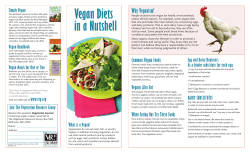
Document 73007
Calcium and Vitamin D If calcium levels in the blood drop below normal, calcium will be “borrowed” from bone. It is very important that your child receives adequate Calcium and Vitamin D to help build healthy bones. Below is listed the Dietary Reference Intake (DRI) for calcium. Receiving the “DRI” ensures that children in the age group listed below will meet their needs with this amount of calcium. Your doctor may suggest a supplement to make sure your child is meeting these goals. Age: Infant 0-6 months Infant 7-12 months 1-3 years 4-8 years 9-13 years 14-18 years 19-30 years DRI for Calcium (milligrams/day): 200 260-500 700 1000 1300 1300 1000 Vitamin D (international units/day): 400 400 600 600 600 600 600 Some important things to remember: • • • • • Taking vitamins and minerals with a meal may increase absorption. If your total daily dose is more than 600 milligrams, then divide your dose and space it throughout the day. Taking a multivitamin does not ensure adequate calcium intake. Most multivitamins provide between 200500 mg of calcium . When taking calcium carbonate read supplement facts for the amount of elemental calcium . Don’t confuse what the pill weighs with the amount of calcium in the pill. Ask your health care provider before starting any vitamin or mineral supplement and tell him/her if your child is on any medications– some supplements may interfere with them. Product: Calcium: Vitamin D: Notes: Viactiv Calcium and D Chews 500 mg 500 IU Calci-mix 500 mg None Soft chocolate, caramel or orange flavored chews Powdered pull-apart capsules Calci-chew D3 Forte 500 mg None Lemon flavor chewable tablets Caltrate 600 Plus Vitamin D3 600 mg 400 IU Oral tablet TUMS Kids 300 mg None Cherry Blast chewable tablets Lil Critters Calcium Gummies 200 mg 200 IU Gummies TUMS ULTRA 400 mg None Assorted Berries, Assorted Fruit, Assorted Tropical Fruit chewable tablets Caltrate 600 plus D 600 mg 400 IU Os-cal Ultra 600 mg 500 IU Calcium Carbonate Liquid 500 mg/5 mL None Chocolate Truffle or Vanilla Cr’eme Chews Caplets Various brands – check your local pharmacy Flintstone's Plus Bone Building Support OsCal 200 mg 400 IU Regular multivitamin 500 mg 600 IU Chewable tablet Oscal Calcium plus D3 500 mg 200 IU Caplet Enfamil D Visol None 400 IU Liquid **Please note – these are current as of May 2011 – confirm calcium and Vitamin D by reading product label. *** Disclaimer: Check with manufacturer for detailed information on food allergies. Boning Up on Calcium It is very important that your child receives adequate Calcium and Vitamin D to help build healthy bones. The information below shows the amount of milk they need to drink each day to take in the Dietary Reference Intake (DRI) for calcium: 1– 3 Years Old = 2 1/2 Cups 4 - 8 Years Old = 3 1/2 Cups 9 –18 Years Old - 4 1/2 Cups Calcium Equivalents: (each equals 300 mg of calcium) - One serving of milk is 8 ounces or 1 cup. You can trade one cup of milk for other foods when you eat the amounts shown below. Items with a yellow star are great sources of vitamin D: 1 cup Milk 1 cup Calcium-fortified soy milk 1 container Yogurt, low-fat or nonfat (6 oz) 1 1/4 cups Calcium-fortified orange juice 2 each Mozzarella string cheese, low moisture, part skim 3 cups Macaroni and cheese 1 1/2 ounce Cheese, hard 3 cups Edamame 1 1/2 cups 4 ounces Canned salmon with bones 1/3 cup Cottage cheese Powder, Non fat dry milk 4-6 average size Sardine with bones 1 1/2 cups Frozen yogurt, milk based 6 ounces Tofu processed with calcium 15 Pudding, low-fat snack cup 1 1/2 cups Broccoli, kale, okra, mustard greens - cooked 3 cups Beans; Red, Pinto, White 3 cups Sweet potatoes CALCIUM INTAKE AND FOOD To increase calcium intake look for foods with added calcium. Examples of calcium fortified foods: Orange and apple juice Breakfast cereal bars English Muffins and other breads Oatmeal and cream of wheat Hot chocolate Soft taco shells Ideas for Increasing Calcium Content in Recipes: ■ ■ ■ ■ ■ ■ ■ Stir 2 tablespoons of nonfat dry milk powder into your favorite beverage. Whip up a smoothie with low-fat milk, nonfat yogurt, fresh fruit, some sweetener and 3 ice cubes. Make hot cereal or soups with milk instead of water. Use milk for instant cocoa instead of water. Use plain yogurt as a substitute for sour cream or mayonnaise in recipes or on a baked potato. Use canned salmon with bones in place of tuna in sandwich spreads, fillings, or on a bagel. Top pasta with tomato sauce and 1/2 cup ricotta cheese or some part-skim mozzarella. Chop tofu or tempeh into a green salad, grill it with herbs or add some to your favorite stir-fry dish. 7/12/11, Children’s Mercy Hospitals & Clinics, Department of Nutrition and Lactation Services (tw & dd)
© Copyright 2025





















